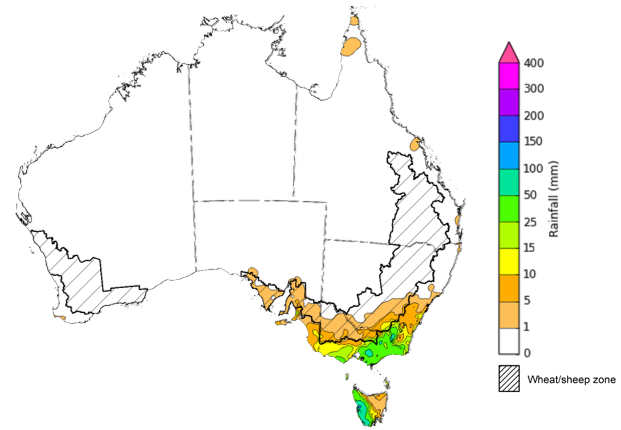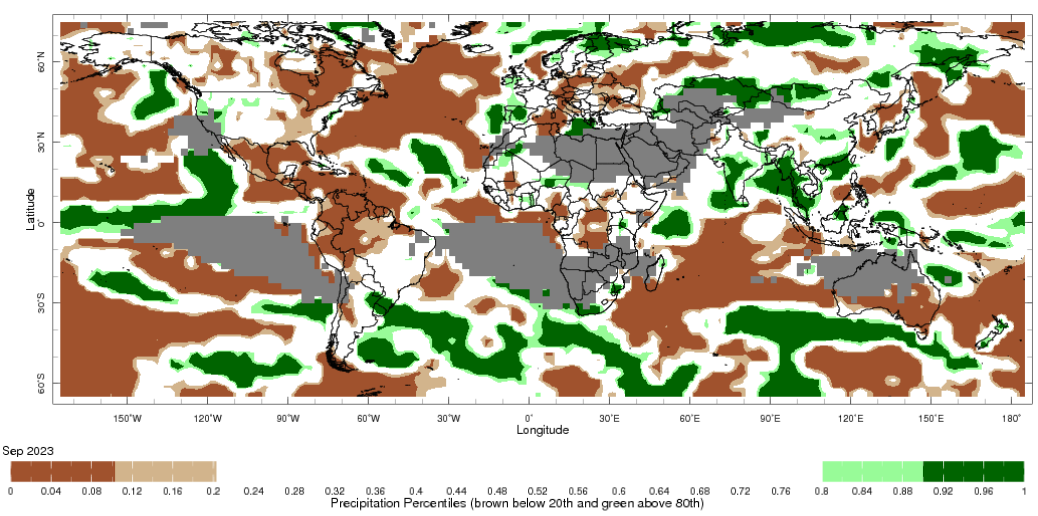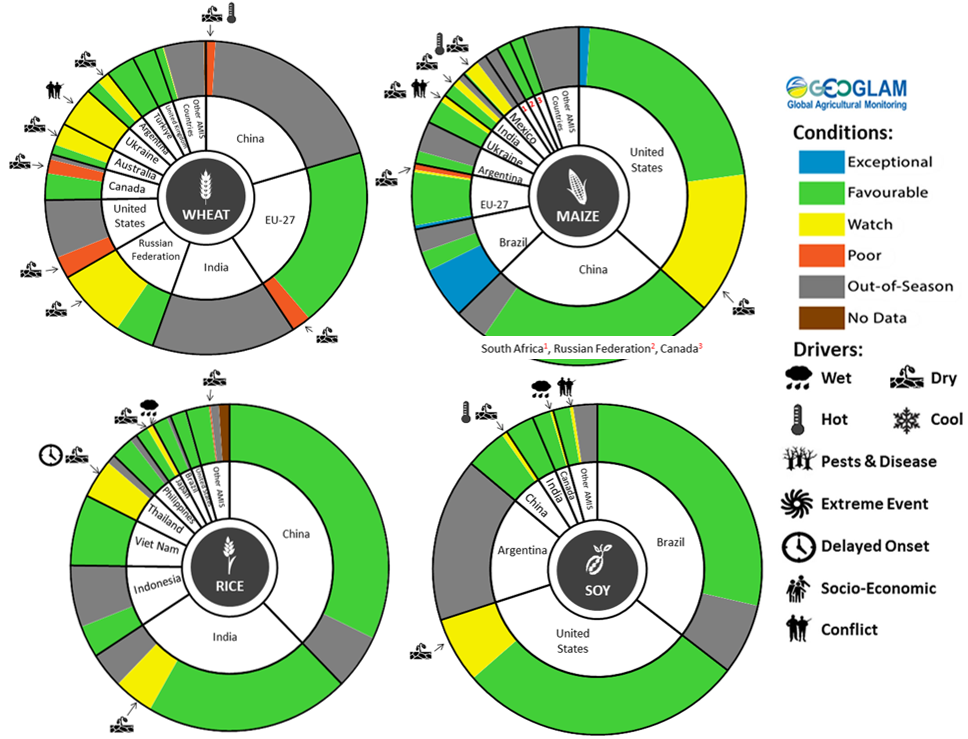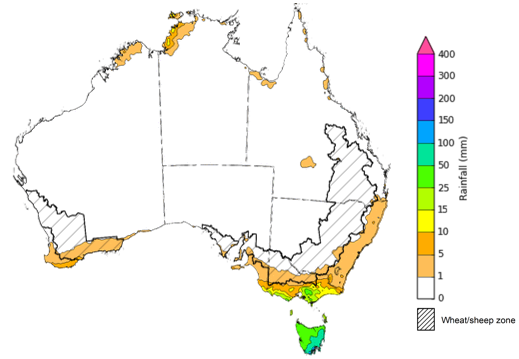Key issues
- For the week ending 18 October 2023, a cold front and trough brought showers to southeastern parts of the country. A high-pressure system kept the remainder of the country dry.
- Across cropping regions, rainfall totals of up to 15 millimetres were recorded in southern New South Wales and up to 10 millimetres in Victoria and South Australia. Given the lack of rainfall across most cropping regions and continuous decline in soil moisture reserves, there continues to be an increased risk of reductions in crop yields at harvest. The dry condition across most cropping regions across northern New South Wales, Queensland and Western Australia would have allowed for the uninterrupted harvest of early planted crops.
- Highly variable rainfall globally during September has led to mixed crop production prospects. Global production conditions were highly variable for wheat, but generally favourable for maize, soybeans and rice. In the northern hemisphere, drought is affecting several areas. In the southern hemisphere, the area affected by dry conditions continues to expand in Argentina and Australia. Global production conditions have continued to deteriorate compared to those used to formulate ABARES forecasts of global grain supplies and world prices in its September 2023 edition of the Agricultural Commodities Report. As a result, global grain and oilseed production is likely to be lower than that forecast in September.
- Over the next 8-days to 26 October 2023, a dry condition is expected across much of the country. A front and a low are likely to bring cooler conditions to southern Australia, but only parts of southern Victoria and Tasmania will benefit from any useful rainfall.
- Across cropping regions, rainfall totals up to 5 millimetres are forecast for southern Victoria and Western Australia while little to no rainfall is expected elsewhere. The dry expected condition across most cropping regions will likely do little to arrest recent declines in yield but will support allow for the uninterrupted harvest of early planted crops.
- Water storage levels in the Murray-Darling Basin (MDB) increased between 12 October 2023 and 19 October 2023 by 31 gigalitres (GL). Current volume of water held in storage is 20 81 GL. This is 6 percent or 1 413 GL less than at the same time last year.
- Allocation prices in the Victorian Murray below the Barmah Choke increased from $178 on 12 October 2023 to $181 on 19 October 2023. Prices are lower in the Goulburn-Broken and regions above the Barmah choke due to the binding of the Goulburn intervalley trade limit and Barmah choke trade constraint.
Climate
For the week ending 18 October 2023, a cold front and trough brought showers to southeastern parts of the country. A high-pressure system kept the remainder of the country dry.
Across cropping regions, rainfall totals of up to 15 millimetres were recorded in southern New South Wales and up to 10 millimetres in Victoria and South Australia. Given the lack of rainfall across most cropping regions and continuous decline in soil moisture reserves, there continues to be an increased risk of reductions in crop yields at harvest. The dry condition across most cropping regions across northern New South Wales, Queensland and Western Australia would have allowed for the uninterrupted harvest of early planted crops.
Rainfall for the week ending 18 October 2023
Issued: 18/10/2023
Note: The rainfall analyses and associated maps utilise data contained in the Bureau of Meteorology climate database, the Australian Data Archive for Meteorology (ADAM). The analyses are initially produced automatically from real-time data with limited quality control. They are intended to provide a general overview of rainfall across Australia as quickly as possible after the observations are received. For further information go to http://www.bom.gov.au/climate/rainfall/
Crop production is affected by long-term trends in average rainfall and temperature, interannual climate variability, shocks during specific growth stages, and extreme weather events. Some crops are more tolerant than others to certain types of stresses, and at each growth stage, different types of stresses affect each crop species in different ways.
The precipitation anomalies and outlooks presented here give an indication of the current and future state of production conditions for the major grain and oilseed producing countries which are responsible for over 80% of global production. This is an important input to assessing the global grain supply outlook.
September precipitation percentiles and current production conditions
As of the end of September 2023, precipitation was highly variable for the world’s major grain-producing and oilseed-producing regions.
In the northern hemisphere, precipitation was generally average to below average across Canada. In the United States (US), precipitation was average to above average, except for eastern areas where it was below average. Precipitation was average to above average in India, the United Kingdom, the European Union (EU), China, and the Russian Federation. September precipitation was generally average across the remainder of the major grain-producing and oilseed-producing regions in the northern hemisphere.
In the southern hemisphere, September precipitation was generally average in South America, with southern and northern parts of Brazil being the main exception, where it was above average and below average, respectively. In Australia, September precipitation was below average.
Global precipitation percentiles, September 2023
Source: International Research Institute for Climate and Society
As of 28 September 2023, global production conditions were highly variable for wheat, but generally favourable for maize, soybeans and rice. In the northern hemisphere, drought is affecting several areas. In the southern hemisphere, the area affected by dry conditions continues to expand in Argentina and Australia.
For wheat, spring wheat harvesting is wrapping up under poor conditions in the US, China and parts of Canada. Ongoing dry conditions continues to affect wheat crops in the southern hemisphere.
For maize, production conditions are generally favourable for most major growing regions, with exceptional conditions are being recorded in Brazil. Dryness is causing some production concerns across parts of the US, the EU, Ukraine, Mexico and India.
For rice, China is experiencing improved conditions after recent rains in the south and southwest. Harvesting of Kharif has begun in India with concerns for below-average monsoonal rains in the south. Harvest conditions are generally favourable in Southeast Asia, except for Thailand where dry conditions persists.
For soybeans, harvesting has begun under generally favourable conditions, with hot and dry weather during the growing season causing some production concerns across parts of the US, China, and Russian Federation.
Crop conditions, AMIS countries, 28 September 2023
Source: AMIS
The global climate outlook for November 2023 to January 2024 indicates that variable rainfall conditions are expected for the world's major grain-producing and oilseed-producing regions.
Outlooks and potential production impacts for the major grain and oilseed producing countries are presented in the table.
Rainfall outlook and potential impact on the future state of production conditions between November 2023 to January 2024
| Region | November 2023 – January 2024 rainfall outlook | Potential impact on production |
|---|---|---|
| Argentina | Average rainfall is likely across the west and above average rainfall is more likely across the rest of Argentina. This pattern is typical during El Niño events. | Average rainfall is likely to support the silking, flowering and grain filling of corn, as well as the flowering of cotton, ground nuts, soybeans and sunflowers. The wet conditions mays also support the planting and vegetative growth of millet, rice and sorghum. |
| Black Sea Region | Average to above average rainfall is more likely in Ukraine, Kazakhstan and the Russian Federation. | Winter wheat and canola will remain dormant throughout November to January across the Black Sea Region. Average to above average rainfall in many parts may provide sufficient snowpack to protect crops from winterkill. |
| Brazil | Well below average rainfall is more likely across much of Brazil except for the far south where above average rainfall is likely, which is a typical El Niño pattern. | Above average rainfall in parts of southern Brazil may adversely affect the harvesting of wheat in November. Meanwhile, below average rainfall is likely to adversely affect flowering of corn, cotton, groundnuts and soybeans, as well as the grain filling on corn in January. Below average rainfall in northern and central Brazil will likely adversely affect the growth, flowering and filling of soybeans. |
| Canada | Average to above average rainfall is more likely for much of Canada, especially across major production regions. | Average to above average rainfall in parts of Canada may delay harvesting and cause grain quality concerns for corn, soybean and sunflower in November. Average to above average rainfall is also likely to provide sufficient snowpack to prevent winterkill of winter wheat and canola through December and January. |
| China | Average to above average rainfall is more likely across China. | Above average rainfall in northern, western and south-eastern China is likely to benefit the harvesting of cotton, corn, sorghum, soybean, sunflower and groundnuts. Wet conditions across northern and western China may boost snowpack, lowering the risk of winterkill for winter wheat and canola. |
| Europe | Average to above average rainfall is more likely across much of Europe. | Above average rainfall may boost snowpack in parts of central Europe, increasing the risk of winterkill for winter wheat and canola. Meanwhile, close to average rainfall through November to January should provide sufficient snowpack for dormant crops in northern Europe. |
| South Asia (India) | Average to above average rainfall is more likely across India. | Average to above average rainfall across much of India will support the harvesting of corn, cotton, groundnuts, millet, rice, sorghum and sunflower. Above average rainfall in parts of northern India will support the vegetative growth and heading of winter wheat and canola. |
| Southeast Asia (SEA) | Generally average to below average rainfall is more likely. | Above average rainfall in SEA is likely to benefit the growth and development of dry-season rice throughout November to January. |
| The United States | Generally average rainfall is likely across most of the US. | Average rainfall across southern US is likely to support harvesting of corn, sorghum and soybeans in November. Average rainfall conditions expected across the northern US is likely to provide sufficient snow cover through December and January to protect winter wheat and canola through dormancy. |
Over the 8-days to 26 October 2023, a dry condition is expected across much of the country. A front and a low are likely to bring cooler conditions to southern Australia, but only parts of southern Victoria and Tasmania will benefit from any useful rainfall.
Across cropping regions, rainfall totals up to 5 millimetres are forecast for southern Victoria and Western Australia while little to no rainfall is expected elsewhere. The dry expected condition across most cropping regions will likely do little to arrest recent declines in yield but will support allow for the uninterrupted harvest of early planted crops.
Total forecast rainfall for the period 19 October 2023 to 26 October 2023
Issued 18/10/2023
Note: This rainfall forecast is produced from computer models. As the model outputs are not altered by weather forecasters, it is important to check local forecasts and warnings issued by the Bureau of Meteorology.
Water
Water storages, water markets and water allocations - current week
The Tableau dashboard may not meet accessibility requirements. For information about the contents of these dashboards contact ABARES.
Commodities
Information on weekly price changes in agricultural commodities is now available at the Weekly commodity price update.




